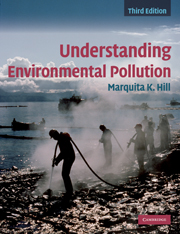Book contents
- Frontmatter
- Contents
- Preface
- Acknowledgements
- List of abbreviations and acronyms
- 1 Understanding pollution
- 2 Reducing risk, reducing pollution
- 3 Chemical toxicity
- 4 Chemical exposures and risk assessment
- 5 Air pollution
- 6 Acid deposition
- 7 Global climate change
- 8 Stratospheric ozone depletion
- 9 Water pollution
- 10 Drinking-water pollution
- 11 Solid waste
- 12 Hazardous waste
- 13 Energy
- 14 Persistent, bioaccumulative, and toxic
- 15 Metals
- 16 Pesticides
- 17 Pollution at home
- 18 Zero waste, zero emissions
- 19 Chemistry: some basic concepts
- Index
- References
8 - Stratospheric ozone depletion
Published online by Cambridge University Press: 05 June 2012
- Frontmatter
- Contents
- Preface
- Acknowledgements
- List of abbreviations and acronyms
- 1 Understanding pollution
- 2 Reducing risk, reducing pollution
- 3 Chemical toxicity
- 4 Chemical exposures and risk assessment
- 5 Air pollution
- 6 Acid deposition
- 7 Global climate change
- 8 Stratospheric ozone depletion
- 9 Water pollution
- 10 Drinking-water pollution
- 11 Solid waste
- 12 Hazardous waste
- 13 Energy
- 14 Persistent, bioaccumulative, and toxic
- 15 Metals
- 16 Pesticides
- 17 Pollution at home
- 18 Zero waste, zero emissions
- 19 Chemistry: some basic concepts
- Index
- References
Summary
“If all the ozone in the atmosphere were compressed to a pressure corresponding to that at the Earth's surface, the layer would be only 3 mm [1/8 inch] thick … The thin ozone lafyer has proved to be an Achilles heel that may be seriously injured by apparently moderate changes in the composition of the atmosphere.”
Swedish Academy of Sciences, announcing the 1995 Nobel Prize in chemistry to Mario Molina, F. Sherwood Rowland, and Paul CrutzenYou are aware of the major pollution problems resulting from combustion, especially of fossil fuels. In this chapter we see a global issue – destruction of stratospheric ozone – which results from CFCs and halons, synthetic chemicals. Depletion of stratospheric ozone led to the 1987 Montreal Protocol, the first worldwide agreement to protect the environment. The ban on ozone-depleting chemicals is largely working, and the ozone layer is expected to recover, albeit slowly. Before starting Chapter 8, see Table 8.1 An ozone-depletion snapshot. ▪ Section I looks at the atmosphere, and reactions in the stratosphere including CFC destruction, and ozone creation and destruction. It examines ultraviolet (UV) radiation, and asks if all ozone-depleting pollutants are equally potent. And does ozone depletion result in measurable increases in UV radiation reaching Earth? After a brief history of ozone depletion, Section II asks: what are the pollutants of concern, how do they destroy ozone, and what is their environmental fate? Over what sections of Earth does ozone depletion occur? Why is the Antarctic particularly susceptible?
- Type
- Chapter
- Information
- Understanding Environmental Pollution , pp. 213 - 235Publisher: Cambridge University PressPrint publication year: 2010



